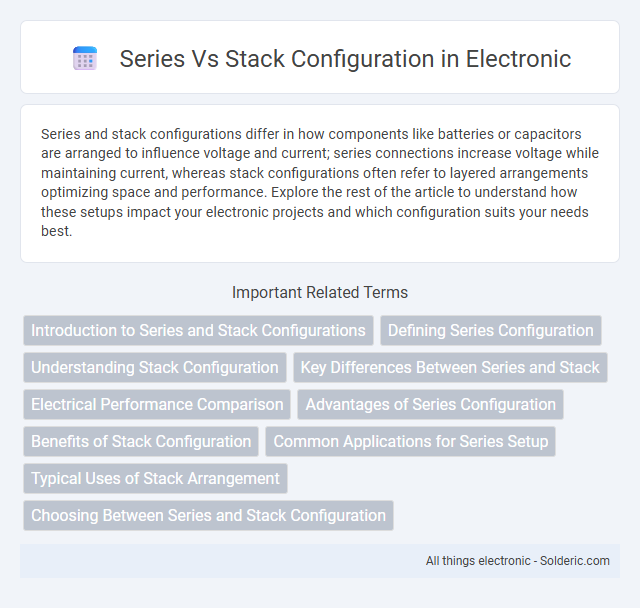Series and stack configurations differ in how components like batteries or capacitors are arranged to influence voltage and current; series connections increase voltage while maintaining current, whereas stack configurations often refer to layered arrangements optimizing space and performance. Explore the rest of the article to understand how these setups impact your electronic projects and which configuration suits your needs best.
Comparison Table
| Feature | Series Configuration | Stack Configuration |
|---|---|---|
| Definition | Components connected end-to-end, current flows sequentially. | Components connected parallelly, voltage remains constant across each. |
| Voltage | Sum of voltages across all components. | Voltage is equal to the voltage of a single component. |
| Current | Same current flows through all components. | Total current is the sum of currents through each branch. |
| Resistance | Total resistance is the sum of individual resistances (R_total = R1 + R2 + ...). | Total resistance decreases (1/R_total = 1/R1 + 1/R2 + ...). |
| Use Case | Battery packs to increase voltage, simpler circuit designs. | Increasing current capacity, reducing total resistance. |
| Failure Impact | Failure in one component breaks the entire circuit. | Failure in one branch does not affect others. |
Introduction to Series and Stack Configurations
Series and stack configurations refer to two common methods of arranging electrical components or systems to achieve specific performance characteristics. In a series configuration, components are connected end-to-end so that the same current flows through each element, optimizing voltage distribution and overall resistance. Stack configuration usually involves layering components, such as batteries or processors, to increase capacity or performance by combining their outputs or functionalities.
Defining Series Configuration
Series configuration connects multiple components end-to-end, creating a single path for current flow. Each component's voltage adds up while the current remains constant throughout the circuit. Your system relies on this setup when you need increased voltage without changing the current.
Understanding Stack Configuration
Stack configuration involves connecting multiple batteries or cells in parallel, which increases overall capacity and current output while maintaining the same voltage. This setup is ideal for applications requiring longer battery life without changing voltage requirements. You can extend device runtime significantly by choosing stack configuration for your power source.
Key Differences Between Series and Stack
Series configuration connects components end-to-end, providing a single path for current flow, which causes voltage to add up while current remains constant. Stack configuration arranges components vertically or in layered structures, optimizing spatial efficiency and often used to enhance performance in batteries or capacitors by increasing capacity or voltage. The key difference lies in electrical behavior: series affects voltage and current linearly, whereas stack impacts physical layout and scalability without altering individual component characteristics.
Electrical Performance Comparison
Series configuration increases total voltage by summing individual cell voltages while maintaining the same current capacity, ideal for high-voltage applications. Stack configuration, often involving parallel connections within each layer, enhances current capacity and reduces internal resistance, improving overall efficiency and thermal management. Your choice depends on whether voltage or current optimization is critical for the electrical performance of your system.
Advantages of Series Configuration
Series configuration offers several advantages, including increased voltage output as the total voltage is the sum of each component's voltage, making it ideal for applications requiring higher voltage levels. It ensures a consistent current flow through all components, enhancing performance uniformity and reducing the risk of current-related damage. Additionally, series wiring simplifies circuit design by minimizing the number of parallel paths, improving reliability and ease of troubleshooting.
Benefits of Stack Configuration
Stack configuration offers enhanced power output by combining voltages of individual cells, making it ideal for applications requiring higher voltage levels. Your system benefits from improved scalability and modularity, allowing easy expansion by adding more stacks. This configuration also provides better fault tolerance, as issues in one cell have less impact on the overall performance compared to series-only arrangements.
Common Applications for Series Setup
Series configuration is commonly used in applications requiring higher voltage output, such as battery packs for electric vehicles and solar power systems, where cells are connected end-to-end to increase total voltage. Series setups are also prevalent in string lighting, emergency lighting systems, and high-voltage power supplies for electronics. This configuration ensures voltage adds up across components while maintaining the same current flow throughout the circuit.
Typical Uses of Stack Arrangement
Stack arrangement is commonly used in applications requiring consistent voltage with increased current capacity, such as battery packs in electric vehicles and renewable energy storage systems. This configuration enhances the overall current output while maintaining the voltage level, making it ideal for power tools, uninterruptible power supplies (UPS), and portable electronic devices. Its ability to share the current load evenly improves system reliability and prolongs component lifespan.
Choosing Between Series and Stack Configuration
Choosing between series and stack configurations depends on your specific electrical needs, such as voltage and current requirements. Series configuration increases voltage by connecting components end-to-end, suitable for devices needing higher voltage but constant current. Your choice should consider the desired power output and safety factors, as stack configurations offer flexibility in combining both series and parallel elements to optimize performance.
Series vs Stack configuration Infographic

 solderic.com
solderic.com